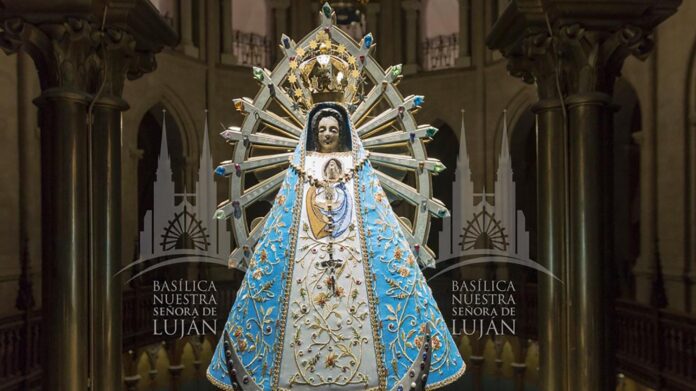As part of the 50th Youth Pilgrimage, over 2.3 million pilgrims gathered at the National Shrine of Our Lady of Lujan in Argentina this past weekend under the theme, “Mother, Under Your Gaze We Seek Unity.”
After trekking more than 37 miles to the shrine, the pilgrims from the Archdiocese of Buenos Aires, which coordinated the trip through the Popular Piety Commission, started to arrive in Luján during the day on Saturday under a bright sun and kept coming in on Sunday.
Priests bestowed blessings upon them, volunteers provided assistance, and musical ensembles from various western Buenos Aires dioceses served as sources of inspiration while they traveled.
Our Lady of Lujan, also known as the Virgin of Lujan, is venerated in Argentina, near the site of the Lujan River.
History of the Figure
The figure of Our Lady of Lujan is a small statue that has been venerated in Argentina since 1630. The tradition of the figure states that, in 1630, a rancher attempted to take the figure from Buenos Aires to his ranch in Santiago del Estero. The oxen who were pulling the wagon stopped inexplicably next to the Lujan River. The oxen would not move again until the figure was taken out of the wagon (despite unloading all other items from the wagon). After repeating this process and finding that the oxen would not move while the figure was in the wagon, the members of the wagon caravan decided this was a sign that the Virgin Mary wanted the statue to remain in Lujan.
Description
The figure of our Lady of Lujan is made of terracotta and was covered in silver in the late 1800s (to protect the figure). Her blue eyes open and her hands folded in prayer, she wears a white robe and blue cloak, which are the colors of the Argentine Flag. The robe and cloak are decorated with flowers and vines, and she wears a golden crown.
Veneration
Originally, the figure of Our Lady of Lujan was venerated in a small chapel near the home of Don Rosenda Oramas, who lived near the spot on the river where the wagons stopped. After 40 years, a larger shrine was built. In the 1800s the image was crowned canonically and was moved to its current sanctuary, which was given the title of Basilica in 1930 by Pope Pius XII.
On May 8, 2013, Pope Francis visited the figure, commending Argentina to the protection of its patroness.
courtesy:https://www.archmil.org/



